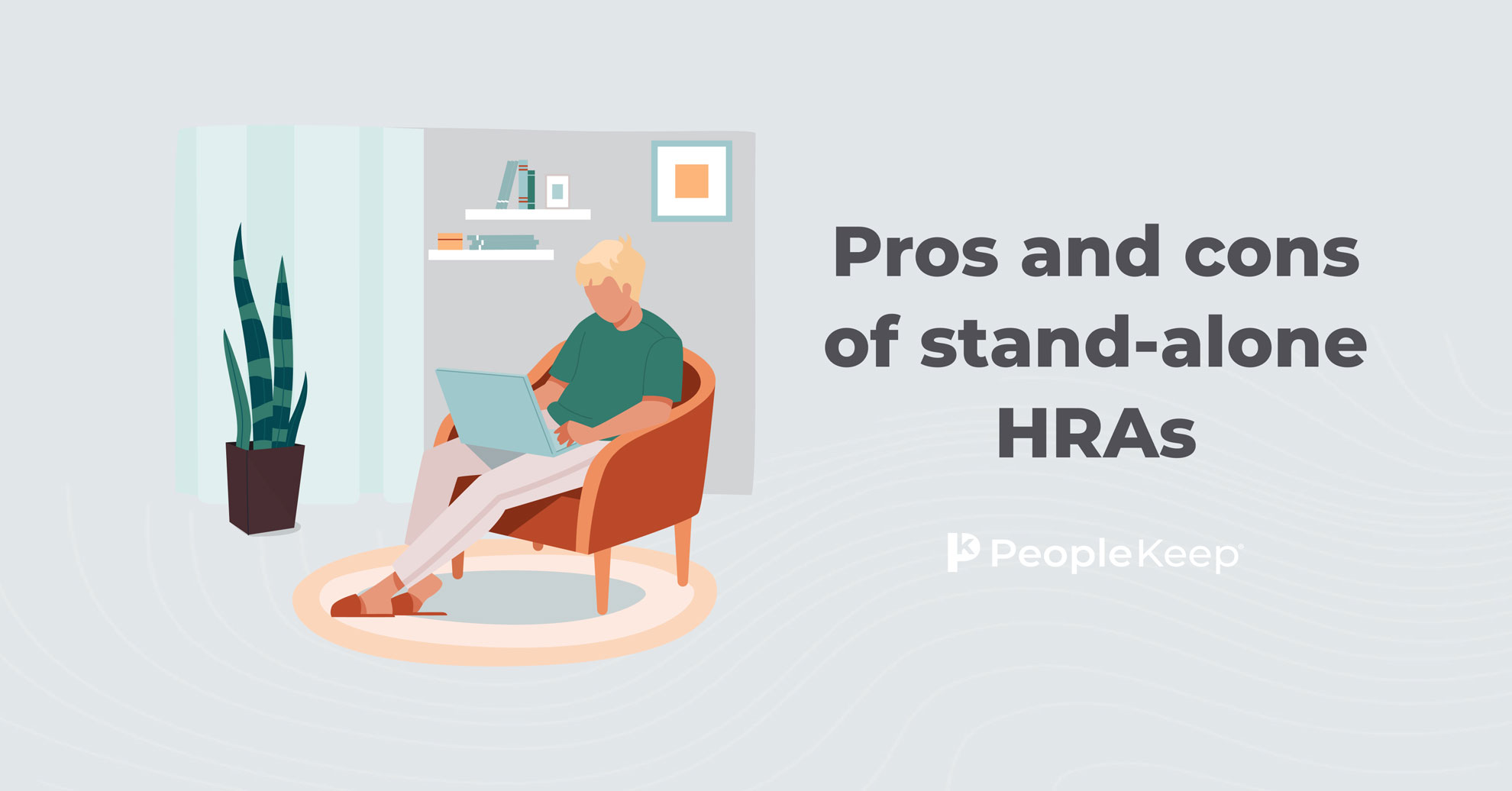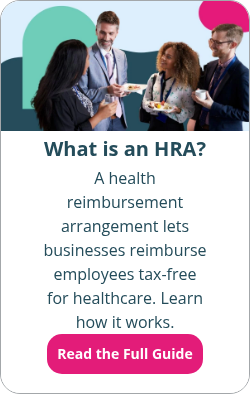Important deadlines for health reimbursement arrangements
By Elizabeth Walker on February 16, 2024 at 9:30 AM
If you’re an employer who has recently set up a health reimbursement arrangement (HRA), you may have questions about required timeframes and deadlines for reimbursing employees’ health expenses and submitting tax forms. Your eligible employees may also want to know how long they have to submit their medical expenses for approval.
As a rule of thumb, the HRA plan documents you draft when setting up the benefit define your reimbursement deadlines. Similarly, the IRS sets compliance regulations and tax form filing deadlines that you must follow to avoid penalties.
The article below will highlight a few of the most important reimbursement, expense submission, and compliance deadlines you’ll need to know to stay on top of your organization’s HRA administration.
Takeaways from this blog post:
- HRA plan documents determine reimbursement deadlines. However, employees who’ve lost eligibility for an HRA typically have 90 days to submit any remaining expenses for reimbursement, provided they incurred the expenses while they were still eligible for the HRA.
- You must follow certain compliance and reporting deadlines to avoid penalties when administrating an HRA, including delivering a summary plan description within a certain timeframe and filing required tax documents like Forms 1094-C, 1095-C, and 5500.
- Employers should notify employees at least 90 days before a new plan year begins (or as soon as possible) for qualified small employer HRAs (QSEHRAs) and individual coverage HRAs (ICHRAs) and provide employees with at least 60 days advanced notice before making any material modifications to their plans.
Expense submission and reimbursement deadlines
Some major HRA deadlines impact when your employees must submit their medical expenses and when you must reimburse them. Let’s go over a few of those scenarios in the sections below.
Reimbursement deadlines for employers
Regardless of the HRA type, you must have formal plan documents to qualify for tax advantages. These plan documents outline HRA timing rules, including the deadline for employers to pay their employees back for the out-of-pocket medical expenses they’ve submitted for reimbursement.
Organizations usually must reimburse healthcare costs within 90 days of approval during the normal life of the plan, also known as the benefit year. The benefit year is the specific length of time an organization sets its plan to run for. Employers should list the date range of the benefit year in their plan documents, along with the effective date.
A typical benefit year spans 12 months but can be shorter or longer depending on how you set up your HRA. For example, an organization may set up its first benefit year to run from August through December and then make subsequent years run from January to December.
Expense submission deadlines for eligible employees
Typically, eligible employees can submit expenses for reimbursement anytime during the benefit year.
For example, if the benefit year begins in January and ends in December, active employees can submit expenses through the end of December. If you offer a runout period, your employees will have until the end of that period to submit any expenses they incurred during the plan year.
It’s a good habit for employees to submit proof of purchase for healthcare items and monthly premiums shortly after they incur them. The IRS requires employees to submit formal documentation or proof of their expenses (like an invoice, explanation of benefits, or a receipt) along with their reimbursement request. Usually, current employees only need to submit health insurance premiums once at the beginning of the plan year to receive monthly reimbursements.
The longer an individual employee waits to submit their expense, the more likely they will lose track of their receipt or written proof of their expense. Without proper proof, they won’t be able to get reimbursed for their purchases.
In most cases, unused amounts expire at the end of the benefit year, meaning employees lose out on their benefit if they miss the deadline. As an employer, it’s a good idea to communicate early and often when deadlines for submitting medical expenses for reimbursement are coming up. That way, your current employees don’t miss out on using their HRA coverage to the fullest.
Expense submission deadlines for newly ineligible employees
In some cases, organizations must reimburse expenses after an employee becomes ineligible for benefits.
An employee may lose plan eligibility for several reasons, including:
- Leaving the organization voluntarily
- Being terminated by their employer
- Having a change in insurance status
Whatever the reason, employees have 90 days after they lose eligibility to submit medical expenses for reimbursement.
However, to receive reimbursement amounts, the employee must have incurred the expense when they were still eligible for the HRA.
Reimbursement deadlines for after the plan year ends
Finally, there are deadlines for when employers can submit reimbursements to employees after the plan year ends. Similar to when they lose eligibility, employees have up to 90 days to submit medical expenses for reimbursement after a benefit year ends. This grace period is known as a runout period.
An employee must have incurred the expense during the benefit year to qualify for reimbursements.
However, this depends on the plan documents. For example, an organization might extend its health reimbursement deadline by 30, 60, or 90 days past the benefit year—giving employees a runout period to submit medical expenses.
Declined reimbursement deadlines
Sometimes, employees may submit claims for reimbursement for items or services that the organization or the IRS doesn’t allow under their benefit guidelines. If you determine the expense is ineligible under an HRA, you must notify the employee within 30 days.
If an employee still needs to include proper proof of purchase with the expense, you can request that they submit additional information to help you verify the request before you approve it. In these situations, you must give the employee 45 days to provide more details.
Compliance and reporting deadlines
Next, let’s review some of the compliance and reporting deadlines you need to know to avoid potential penalties when administrating your HRA.
Summary plan description
A summary plan description (SPD) summarizes your benefit and outlines the plan's details and requirements. It's the primary way you’ll communicate rights and obligations to your current employees, so you should write it in plain language that your plan participants can easily understand.
For first-time HRAs, you must deliver the SPD within 120 days of establishing the plan. For newly eligible participants in an existing HRA, you must provide the SPD within 90 days of their first date of coverage under the plan. You can distribute it to your employees by USPS First-Class Mail, hand delivery at your worksites, and electronic delivery with notice.
You're not meeting your compliance requirements if you offer an HRA without an SPD. The Department of Labor can penalize you up to $110 per day if you don't provide one within 30 days after an employee requests it.
Forms 1094-C and 1095-C
If you’re an organization with 50 or more full-time equivalent employees (FTEs), known as an applicable large employer (ALE), using an individual coverage HRA (ICHRA) to satisfy the Affordable Care Act’s employer mandate, you must file Forms 1094-C and 1095-C. You’ll use Form 1095-C to show you offered your employees an affordable ICHRA benefit.
You must provide a completed Form 1095-C to your employees by January 31 each year. You should also summarize your 1095 forms on Form 1094-C, which is due by March 31 if filing electronically. You can face costly penalties if you don’t file Forms 1094 or 1095. So, work with a tax professional for additional guidance to complete them accurately and on time.
To learn more about Form 1095, check out our complete guide
Form 5500 and the Summary Annual Report
Form 5500 is an annual report including information about a benefit plan's financial condition and operations that organizations file with the Department of Labor. All organizations offering benefits subject to the Employee Retirement Income Security Act of 1974 (ERISA) must file Form 5500.
Because HRAs are subject to ERISA, you must complete Form 5500. However, depending on the number of participants in your plans, your filing method and form version may vary.
Form 5500 is due for most organizations on the last day of the seventh month following the plan year. For calendar year plans starting January 1 each year, this is July 31. You can request extensions of up to two and a half months by filing Form 5558 with the IRS before the deadline.
The Summary Annual Report summarizes Form 5500. You must distribute this report to plan participants within nine months after the plan year ends. For calendar year plans, this is September 30.
Read more about the Summary Annual Report in our blog.
90-day notification period
Federal guidelines recommend that you notify employees at least 90 days before a new plan year begins for any employee currently enrolled in a qualified small employer HRA (QSEHRA). If you’re offering the benefit to a newly eligible employee, like a new hire, you must give notice on or before the first day they’re eligible to participate.
In the case of an ICHRA, the 90-day notice is so employees have enough time to decide whether or not they want to opt in or out of the benefit. You must provide a written notice every year you offer the ICHRA.
If you offer HRA coverage through PeopleKeep, our software automatically sends email notifications to employees based on the schedule you set.
The 60-day notice of material modification
Like many other self-insured plans, some types of HRAs require you to distribute a summary of benefits and coverage (SBC) to your employees. SBCs are short documents that describe your health benefit in plain language and help employees compare insurance coverage at a glance.
If you make any plan changes that affect the content of the SBC, it triggers the 60-day notice requirement.
Also known as the 60-day notice of material modification, the Affordable Care Act (ACA) requires employers to provide employees with at least 60 days advanced notice before making any material modifications to their health plan. These modifications can include changes to coverage, cost-sharing, network providers, or any other plan terms that may impact an employee's benefits.
Sending this notice is mandatory; otherwise, you may experience steep fines. However, there are situations where you may be exempt from the 60-day notice.
Learn more about the 60-day notice of material modification in our full guide.
PCORI fees
All employers offering a QSEHRA or an ICHRA must pay a yearly fee to the Patient-Centered Outcomes Research Institute (PCORI) and submit Form 720. This fee applies regardless of your company’s size.
The PCORI fee for plans ending before October 1, 2023, is $3 per covered life. The fee for plan years ending on or after October 1, 2023, is $3.22 per covered life.
This fee is due by July 31 following the plan year. Initially, this fee was to expire in 2019. However, the Further Consolidated Appropriations Act of 2020 extended it through 20291.
W-2 reporting
Employers must report QSEHRA allowances on employees’ W-2s using code FF in Box 12. QSEHRA allowances are free of payroll taxes for the employer and employee. It is also free of income tax as long as the employee has minimum essential coverage (MEC).
Learn more about reporting QSEHRAs on W-2s in our article.
Need help keeping track of deadlines?
If you use benefits administration software like PeopleKeep, you and your employees don’t have to keep track of HRA reimbursement deadlines on your own. PeopleKeep helps thousands of organizations keep track of reimbursement amounts and requests and even sends out automatic reminders.
What’s more, you’ll have access to our award-winning customer support team whenever you or your employees have questions about which healthcare costs qualify, when deadlines are coming up, or anything in between.
Conclusion
An HRA is an excellent way for organizations to offer their employees personalized and flexible health plan coverage—but it’s your job to make sure important deadlines don’t pass you by. With the help of PeopleKeep’s administrative support software, you can take a backseat while our software and customer support team does all the heavy lifting.
Check out more resources
See these related articles

How to calculate FTEs to determine ALE status
Learn what a full-time equivalent employee (FTE) is, what your FTE number means if you’re an ALE, and how to calculate how many FTEs you employ.

Pros and cons of stand-alone HRAs
Stand-alone HRAs can offer flexibility and control over healthcare expenses, allowing employers to customize plans to meet their employees' needs.

HRAs and W-2 annual reporting
Learn about HRA W-2 annual reporting requirements. Understand what employers need to include on employees' W-2 forms for HRA compliance.



